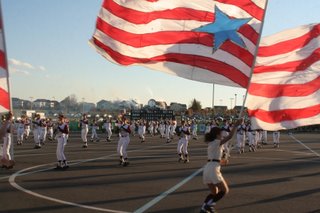The two elements are, the marching band achieving a superior grade, and have the top concert band in the spring achieve a superior grade at Concert Band Festival. Achieving two superior grades is a challenge with less than one out of twenty high schools achieving Honor Band in a given year….only a handful of schools have earned the Honor Band rank for more than four consecutive years.
Oakton has been an Honor Band thirteen in the last sixteen years (they earned their 10th during Jonathan's senior year). Last year was not one of them as its marking as the marching band fell short of the superior grade by one point from one of the five judges.
This year Oakton (classed at States as a class 5A band) has taken the first step to return to the Honor Band status by earning early Saturday evening a superior rating. Eight bands achieved that rating in the northern Virginia competition (one 2A, two 3As, three 4As, three 5As….class is by size of the bands). As you will see from the pics, the competition was held on the marching field but on the driver’s education track. As it had rained all day Friday and into the early hours the morning it was felt that the field could not stand up to having thirty-two bands upon it in one day. Sustained winds of 30 mph with gusts up to 45 mph increased the challenge…keeping hats on and for the guard flag drills. Due to the wind the guard had to forgo tossing the flags and drawing out the giant baseball flag (20’ by 40’).
The first pic from early in the show is the front end of the baseball diamond formation. The second pic is of seventh inning stretch where the band and audience sings “Take Me Out To the Ball Game” (Josh is in the five player ensemble in the center of the field).
Yes, in the third pic, that is fireworks going off from the scoreboard following the shooting of a cannon (placed behind the scoreboard). Throughout the performance, the score on the scoreboard changes. Also, on the scoreboard you will see the clock is set to the time of the performance…something that I did for the first competition in Winchester and the back crew continued doing throughout the season. The last pic shows Josh as a backfield conductor as the band moves away from the drum majors at the end of the show. You will also notice due to the wind three parents behind Josh holding the fence.
Other pics from the State Competition should be posted on Oakton’s web page later this week and join the other pics Evie and I have taken throughout the season.



















